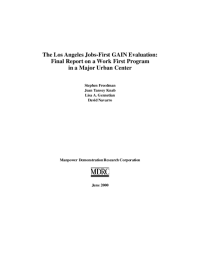The Los Angeles Jobs-First GAIN Evaluation
Final Report on a Work First Program in a Major Urban Center
This document summarizes the two-year findings from a large-scale, rigorous evaluation of Jobs-First GAIN, a strongly employment-focused mandatory welfare-to-work program. The Los Angeles County Department of Public Social Services (DPSS) operated Jobs-First GAIN from January 1995 through March 1998. The evaluation, conducted by the Manpower Demonstration Research Corporation (MDRC), has been jointly funded by DPSS, the U.S. Department of Health and Human Services, and the Ford Foundation. Los Angeles operates the largest county welfare program in the nation, serving more recipients than all states except New York and California. The size and diversity of Los Angeles County’s population mean that any success achieved by Jobs-First GAIN will have broad significance.
In a report on the Jobs-First GAIN Evaluation after one year of follow-up (year 1), it was concluded that Jobs-First GAIN produced substantial increases in employment and earnings and reductions in welfare expenditures relative to what welfare recipients would have achieved had they not entered the program. Furthermore, the program produced positive results for many different types of welfare recipients. The report summarized here examines whether Jobs-First GAIN sustained these effects through a second year of follow-up (year 2). It then assesses the program’s two-year effects on a wide range of additional outcomes, including (1) employment stability and wage growth, (2) income and self-sufficiency, (3) medical coverage, (4) child care use, (5) household structure, (6) food insecurity, and (7) children’s academic and behavioral adjustment and safety. The report also examines Jobs-First GAIN’s cost-effectiveness.
Jobs-First GAIN anticipated the philosophy and goals of the federal Personal Responsibility and Work Opportunity Reconciliation Act (PRWORA) of 1996, which replaced Aid to Families with Dependent Children (AFDC), the nation’s largest cash welfare program, with block grants to the states called Temporary Assistance for Needy Families (TANF). (This type of cash assistance is referred to here as AFDC/TANF or welfare.) Jobs-First GAIN emphasized job search assistance and imparted a strong pro-work message in an effort to move thousands of welfare recipients quickly into jobs. Its message and emphasis place Jobs-First GAIN in the category of Work First programs, the approach strongly encouraged by PRWORA and followed by most current state and local welfare-to-work programs. Most features of Jobs-First GAIN continued under Los Angeles County’s TANF program, California Work Opportunity and Responsibility to Kids (CalWORKs), which replaced Jobs-First GAIN in April 1998.
The similarities between Jobs-First GAIN and its successor, CalWORKs, make the findings of this evaluation especially useful to practitioners and researchers who need reliable information on the effects of TANF-era welfare-to-work initiatives in large urban settings. The differences between Jobs-First GAIN and CalWORKs are also important. Like many other TANF-era programs, CalWORKs modified the Jobs-First GAIN program model by adding time limits on welfare eligibility (although only for adult recipients), somewhat stronger financial incentives to work, extended transitional benefits, post-employment services aimed at increasing job retention and advancement, and special services for victims of domestic violence and people with mental health or substance abuse problems. The Jobs-First GAIN Evaluation therefore tests the effects of CalWORKs’ primary pre-employment strategy (and that of many other TANF-era programs), but without time limits and post-employment and special services and with smaller financial incentives to keep working. Jobs-First GAIN’s effects on employment, earnings, welfare dependency, and income will serve as a benchmark for gauging the effects of CalWORKs’ (and other TANF programs’) more comprehensive approach to promoting self-sufficiency.
Jobs-First GAIN, which encouraged welfare recipients to start working as soon as possible, replaced Los Angeles GAIN, the county’s previous GAIN (Greater Avenues for Independence) program, which encouraged welfare recipients to return to school to improve their basic skills. Launched in 1988, Los Angeles GAIN assigned most of its enrollees, all of whom were long-term welfare recipients, to adult basic education (remedial English and math), General Educational Development (GED) test preparation, or English as a Second Language classes. Relatively few enrollees were assigned to job search activities. Evidence from several sources, including an evaluation of the program by MDRC, convinced DPSS’s top administrators that Los Angeles GAIN’s basic education approach, despite being costly, helped relatively few people find employment. The administrators resolved that adopting a Work First approach would benefit welfare recipients financially and save taxpayer dollars. The Jobs-First GAIN Evaluation tests this premise by comparing Jobs-First GAIN’s effects with those of the county’s earlier GAIN program. The findings from this comparison are important because administrators in many other localities made similar changes to their welfare-to-work programs during the 1990s.
Central to the evaluation is an experimental design based on random assignment. From April 1 through September 11, 1996, nearly 21,000 single parents (AFDC-FGs, or Family Group cases) and members of two-parent households (AFDC-Us, or Unemployed Parent cases) who showed up at a Jobs-First GAIN office for their scheduled orientation were randomly assigned either to the experimental group or to the control group. Experimental group members had access to Jobs-First GAIN’s program services and exposure to its Work First message. They were also subject to the program’s mandatory participation requirements and could incur a sanction — a reduction in their welfare grant — for noncompliance. Control group members were precluded from receiving Jobs-First GAIN services until October 1998, the end of the follow-up period for the evaluation, but remained eligible to receive welfare and Food Stamps. Control group members could also seek out other services in the community and receive child care assistance from DPSS for employment-related programs in which they enrolled on their own initiative. Finally, both experimental and control group members were covered by California’s Work Pays rules for calculating welfare grants. Work Pays allowed most welfare recipients who found a job to continue receiving welfare benefits and to retain their eligibility for Medicaid.







